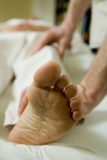
Deep vein thrombosis, or DVT, is a blood clot that forms in a vein deep in the body. Most deep vein clots occur in the lower leg or thigh. If the vein swells, the condition is called thrombophlebitis. A deep vein thrombosis can break loose and cause a serious problem in the lung, called a pulmonary embolism, or a heart attack or stroke.
Sitting still for a long time can make you more likely to get a DVT. Some medicines and disorders that increase your risk for blood clots can also lead to DVTs.
Common symptoms are:
Warmth and tenderness over the vein
Pain or swelling in the part of the body affected
Skin redness
Treatment includes:
Medicines to ease pain and inflammation, break up clots and keep new clots from forming.
Keeping the affected area raised and applying moist heat can also help.
If you are taking a long car or plane trip, take a break, walk or stretch your legs and drink plenty of liquids.
Deep Vein Thrombosis (DVT) and Pulmonary Embolism (PE) are a major public health problem in the United States. Estimates suggest that 350,000 to 600,000 Americans have a DVT or PE each year, and that at least 100,000 people die as a result. Many of those who have a DVT or PE also have complications that can greatly impact their quality of life.
Everybody should know the risk factors, symptoms, and steps they can take to protect themselves.
Factors that increase the risk of developing DVT include:
Major surgery
Immobility, such as being in the hospital and long travel
Recent injury
Increased estrogen, from birth control pills, pregnancy, and certain medications
Certain chronic medical illnesses, such as heart disease and cancer
Previous DVT
Age (risk increases as age increases)
Obesity
Smoking
Know the symptoms of DVT and PE:
Symptoms of DVT:
About half of people with DVT have no symptoms at all.
For those who do have symptoms, the following are the most common and occur in the affected part of the body (usually the leg):
Swelling
Pain
Tenderness
Redness of the skin
Symptoms ofPulmonary Embolism (PE):
If you have a PE, you might:
Find it hard to breathe
Have a faster than normal heart beat
Have chest pain or discomfort, which usually worse with a deep breath or coughing
Cough up blood
Have very low blood pressure or lightheadedness, or black out
If you have any of these symptoms, you should seek medical help immediately.
Steps you can take to protect yourself:
When sitting for long periods of time, such as when traveling for more than four hours:
Get up and walk around every 2 to 3 hours.
Exercise your legs while you're sitting by:
Raising and lowering your heels while keeping your toes on the floor.
Raising and lowering your toes while keeping your heels on the floor.
Tightening and releasing your leg muscles.
Drink plenty of water, and avoid drinking anything with alcohol or caffeine in it.
Move around as soon as possible after having been confined to bed, such as after surgery, illness, or injury.
If you are at increased risk, talk to your doctor about wearing graduated compression stockings (sometimes called “support hose” or “medical compression stockings”).
If you are at increased risk, talk to your doctor about medication (anticoagulants) to prevent or treat DVT.
Exercise regularly, maintain a healthy weight, and don’t smoke.
